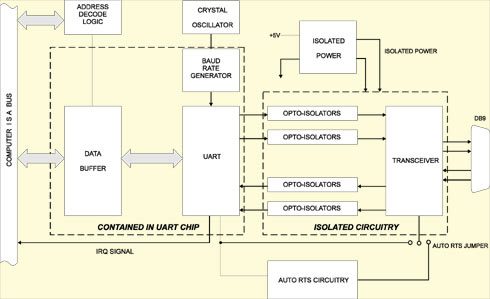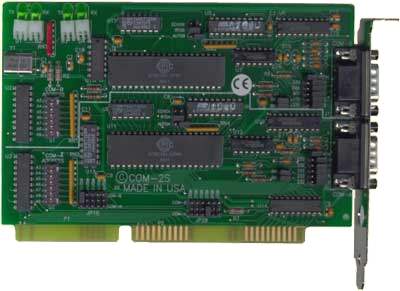ICOM-1S and ICOM-2S
Features
- Completely configurable, asynchronous serial port (ICOM-2S has two ports).
- Opto-Isolated against noisy environments
- Support conventional High-speed RS-422, and Multi-drop RS-485
- Can be wired for 2 or 4 wire RS-422/485 communications
- Support RS-485 handshaking on-board without special drivers to support Windows and non-DOS programs
- Built-in support for local echo, line termination, and line bias supplies
- Supports extended AT interrupts
- LED status monitors on transmit and receive lines for troubleshooting
- Designed, made, supported, and manufactured in the USA
Price range: $214.00 through $283.00
In StockDescription
Model ICOM-2S is a dual-port card that can be used in ISA Bus computers and is designed for transmission/reception over long bus lines in noisy environments. Model ICOM-1S is a single-port, de-populated version of this card. The opto-isolators assure reliable communication when large common mode noise is superimposed on the transmit/receive lines. Opto-isolators are also provided on the RTS and CTS handshaking control lines. Further, an on-board DC-DC converter provides isolated +5 VDC to power the transceiver and RTS and CTS circuits. Transorbs are optionally available to absorb potentially damaging voltage spikes created by equipment or lightning.
The card supports all of the most popular asynchronous communication protocols. RS-422 mode differential drivers extend the distance and speed. RS-485 mode uses tri-state drivers to produce a multi-drop network of up to 32 cards on a single twisted pair. RS-485 multidrop communications requires the transmitter drivers to be enabled and disabled as needed to allow the ports to share the common communication lines. These cards have two methods to control the drivers: automatic (AUTO) and Request to Send (RTS) control. Under automatic control, the port is normally in the receive mode and the driver is enabled only when data is ready to be transmitted. The driver is then enabled and remains enabled throughout the transmission plus the transmission time of one character after data transfer is complete. Then it is disabled. The cards automatically adjusts their timing to the baud rate of the data. When operating with Windows programs, this AUTO mode is mandatory. With RTS control, your application software must enable/disable the driver.
The card is 100 percent compatible with MS-DOS with support for the standard COM1 through COM4 serial port address. However, you are not limited only to those addresses. Continuous address selection is available anywhere in the I/O address range of 000 to 3FF (hex). Interrupt levels from IRQ2 to IRQ14 (Except for IRQ 8, 9, and 13 which are always reserved by the IBM hardware) are supported. A crystal controlled oscillator is located on the card. This oscillator permits selection from standard baud rates from 50 to 115,200 baud. The opto-isolators limit operation to 38,400 baud but higher speed isolators are optionally available. For operation above 115K baud a non-isolated card, such as the COM-2S, which has the capability of even higher speeds should be considered.
The transceiver used, a type 75176, is capable of driving extremely long communication lines at high baud rates. It is capable of driving up to 60 mA on balanced lines and receiving inputs as low as 200 mV differential signal. Also, in case of communication conflict, the transceivers feature thermal shutdown.
In addition to differential Transmit and Receive lines, single-ended, buffered RTS and CTS lines are provided at the I/O connector. Normally, CTS must be pulled up to +5 VDC for the card to operate but you can position a jumper so that the card will auto-detect the transition between transmit and receive operations. These cards support full duplex, half duplex and simplex operations selected by jumpers.
A transmission line should be terminated at the receiving end in its characteristic impedance. You can install a jumper (LD) which applies a 136 ohm load across the input for RS-422 mode and across the transmit/receive input/output for RS-485 operation. When noise is a potential problem on long lines, the terminating resistor should be divided and its center point grounded to help reduce noise voltage pickup. To accomplish this, you can also install a jumper (LD GND) for 68-ohm termination resistance on the positive and negative branches of the receiving line.
In RS-485 operations, where there are multiple terminals, only the RS-485 ports at each end of the network should have terminating resistors as described above. If the card is to have an ungrounded load, do as above except do not install the LD GND jumper. Also, for RS-485 operation, there must be a bias on the RX+ and RX- lines. If the COM422/485 card is to provide that bias, install jumpers at the locations labeled +BIAS and -BIAS.
OPTIONS
- Tranzorbs to absorb potentially damaging voltage spikes occurring due to lightning or other transmitted electrical interference.
- High-speed crystal oscillators to achieve unique or higher baud rates.
Downloads
Manuals
Software
- ICOM-1S Software Package ( -- Last Uploaded 2025-05-07)
Drivers and Downloads
Full list of available Downloads: Software Packages, Drivers, Manuals, and other documents
Information about our Free Software packages:
ACCES is proud to provide a full suite of software support with every Data Acquisition product. We are committed to supporting the most popular operating systems and platforms for our customers. Currently we are actively supporting 7 -> 11, both 32 & 64 bit, including “Server 2008,” “Embedded,” and “Compact” flavors for all plug-and-play products including PCI, PCI Express, USB, and more. Many products continue to ship with support for additional operating systems such as DOS, Windows 95, 98, Me, NT4, 2000, and XP.
Samples
Among the software we deliver with our products are sample programs in a wide variety of programming languages. These samples are used to demonstrate the software interfaces to our products — and many can be used as-is in your production environments, or to test functionality of the devices out-of-the-box. We’re currently actively supporting sample programs in Microsoft Visual C#, and Delphi, with many devices including samples in Visual Basic (5 and .NET), Visual C/C++, and Borland C/C++ 3.1 for DOS. Additionally we provide National Instruments LabVIEW compatible DLLs and many demonstration VIs for our devices.
Drivers
Drivers for various operating systems are also provided, including active support for Windows 7 -> 11 — all in both 32-bit and 64-bit flavors, and including consumer, server, and embedded varieties — as well as the 2.6 and newer Linux kernels and recent OSX / macOS versions. Many products continue to ship with driver support for Windows 95, 98, Me, NT4, Windows 2000, XP, and more, but support for these operating systems is considered deprecated.
Setup Programs and Utilities
Our Data Acquisition devices also include a graphical setup utility that walks you through the process of configuring any option jumpers or switches on the device, as well as explaining a little about the various connectors present.
Many devices also include utility programs – little tools to make your use of the device easier, such as EWriter, a program that allows you to read and write data in the user-accessible EEPROM locations on all our USB data acquisition products; or WinRISC, a “Really Incredibly Simple Communications” terminal program that lets you get started instantly with serial devices.
“Register Level” Documentation
Besides all this software in all these languages and operating systems ACCES has a policy of open and transparent development: none of our lowest-level “register” interfaces are hidden from you — we document every register in every bus card, every command in every serial board, and every usb control transfer in every USB Data Acquisition board. These lowest-level interfaces allow you to develop for our products in ANY operating system or language, regardless of our actively supporting it or having a driver for it. We have customers actively developing in ADA, Android, Python, Java, MATLAB, Solaris, and more, just by referring to our complete low-level interface documentation! And we provide the full source code to all of our drivers, regardless of operating system, to give you an even bigger head start in your own development tasks.
No Fees or Royalties
All of this software is provided at no additional charge, and is licensed under any of a variety of flexible — and royalty free — options. Check out our software license explanation if you’d like more information.
Custom Software
ACCES also offers Custom Software Services for our products. Our prices are unbelievably low, often as inexpensive as free! If you need something tweaked to support your needs, or an entire enterprise application developed from scratch, it is definitely worth your time to inquire with us, first.
Further information about available ACCES Software:
Redistributing Windows Drivers
A list of ACCES drivers and the files that compose them under different versions of Windows, so you can easily redistribute ACCES cards and drivers.

COMMUNICATIONS INTERFACE
- Serial Ports: One or two shielded male D-sub 9-pin IBM AT style connectors compatible with RS-422 and RS-485 specifications.
- Input Isolation: 60 Volts, signal to ground and signal to signal.
- Character length: 5, 6, 7, or 8 bits.
- Parity: Even, odd or none.
- Stop Interval: 1, 1.5, or 2 bits.
- Serial Data Rates: 50 to 38,400 (Faster or custom rates available), Asynchronous, Type 16550 buffered UART.
- Address: Continuously mappable within 000 to 3FF (hex) range of AT I/O bus addresses.
RS422/RS485 DIFFERENTIAL COMMUNICATION MODE
- Multipoint: Compatible with RS422 and RS485 specifications. Up to 32 drivers and receivers allowed on RS485 line. Serial communications ACE used is type 16550. Driver/Receivers used are type 75ALS180.
- Input Isolation: 60V signal to ground and signal to signal.
- Receiver Input Sensitivity: +200 mV, differential input.
- Common Mode Rejection: +12V to -7V
- Transmitter Output Drive Capability: 60 mA, with thermal shutdown.
ENVIRONMENTAL
- Operating Temperature: 0 to +60° C.
- Storage Temperature: -50 to +120° C.
- Humidity: 0% to 95% non condensing.
- Size: 10.75 inches long (273mm)
POWER REQUIREMENTS
- +5 VDC at 1580mA typical
- +12 VDC at 2000 mA typical
Regulatory Compliance
- This product is in full compliance with CE requirements.
| Model | Description | Price (USD) | |
|---|---|---|---|
| ICOM-2S | 2 port, RS422/RS485 ISA Card | $283.00 | |
| ICOM-1S | 1 port, RS422/RS485 ISA Card | $214.00 |

